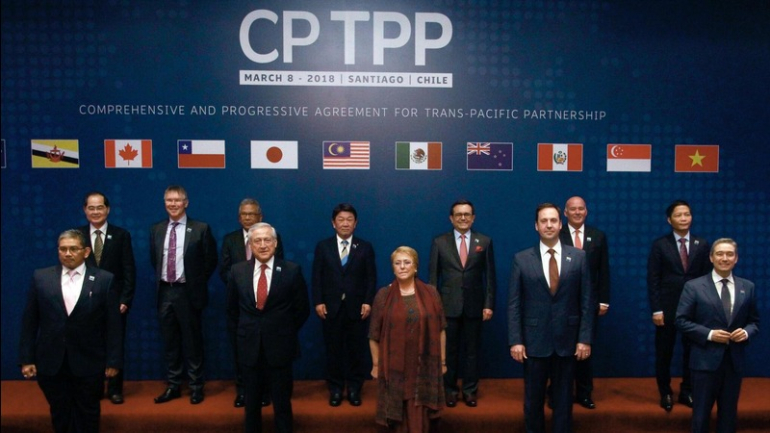28 September 2022
Authors: Professor James Laurenceson, University of Technology Sydney, and Associate Professor Weihuan Zhou, UNSW.
It is understandable that many Australians, after more than two years of being hit with trade sanctions, would be receptive to claims that China is hopelessly non-compliant with international trade rules. If this were the case, there would be no point imagining that institutions such as the World Trade Organisation were capable of restraining Beijing’s behaviour.
And as Japanese ambassador Shingo Yamagami recently argued, to allow China to join agreements such as the Comprehensive and Progressive Agreement for Trans-Pacific Partnership could ‘compromise its integrity’ and risk ‘sabotage from within’.
He insisted the US, on the other hand, should be welcomed with open arms. But many of the region’s smaller, trade-exposed economies that are vulnerable to rule-breaking do not appear to be convinced.
In May, Singapore Prime Minister Lee Hsien Loong said China’s application to join the CPTPP should be welcomed. His reasoning: it is far better for the Chinese economy to be integrated into the region than to operate by a different set of rules. New Zealand and Malaysia agree.
Meanwhile Vietnam, another Communist Party-led state, has offered to share information with Beijing about its own CPTPP accession experience.
A talking point advanced with vigour by Washington is that, despite smoothing the way for China’s WTO entry in 2001, Beijing failed to follow through on its commitments to ‘complete a transformation to a market-oriented economy and trade regime’.
Yet in 2000 the US trade representative at the time, Charlene Barshefsky, made clear the US had ‘not given up anything in this agreement’ and ‘secured comprehensive, one-way concessions, opening China’s markets’. Further, there would be a ‘set of rules and commitments which are enforceable and subject to multilateral scrutiny’. The price China paid for WTO entry was high. Barshefsky was praised in congress for obtaining concessions that ‘far exceeded what anyone would have expected’.
Even today, China’s so-called WTO-plus obligations remain the most extensive and onerous among all WTO members. To implement its WTO commitments, China amended thousands of laws and regulations and reduced barriers to foreign goods, services and investment. These are all empirical facts. In 2007, the US trade representative acknowledged China had taken ‘impressive steps to reform its economy’.
Certainly there is room for China’s compliance to improve. But the relevant metric is not perfection. After all, the US is a respondent on more than three times as many WTO disputes (156) as China (49).
And some members have challenged Beijing’s compliance and won. The evidence is that when faced with an unfavourable WTO ruling, China has brought itself into compliance. In contrast, the US record of implementing WTO rulings has been found to be the worst of any member.
Misinformation needs to be called out. As a global institution, the WTO does not mandate one development model or political system over another. Nonetheless, to achieve entry, China committed to, then delivered, large-scale, market-oriented reforms.
It is also the case that international trade rules are incomplete. But with respect to many common grievances, such as Beijing’s use of industrial subsidies, trade law scholars argue existing rules already enable challenges to China’s practices. Rather than pursue this channel, the US sought to coerce China by imposing tariffs that the WTO subsequently judged to be illegal. It also drove the WTO’s appeals body into dysfunction, preventing Beijing from seeking legal recourse.
Last month, the US rejected for the 57th time a proposal by Australia, China and 124 other WTO members to restore the body. Simultaneously, the US is ratcheting up its own industrial policies, supported by subsidies – the latest example legislation committing $US52bn to support the domestic semiconductor sector.
The only solution to trade grievances with China is to make use of the China-specific rules under the WTO; and when new rules are needed, do the job of negotiating them. Alternatively, sign China up to existing agreements that build on existing WTO minimums, such as the CPTPP. While Beijing has applied to join the CPTPP, US Democrats and Republicans reject participation.
In a mutual display of good faith, Australia and China are engaging via the WTO to resolve several of their disputes, committing to an interim appeals procedure for as long as the US stifles the regular one. Both also are engaging in negotiations under the WTO to address first-order challenges of today, such as sustainable development and rules on digital trade. For Australia, a confrontational approach that singles out China is a dead end.
No one is suggesting that China be allowed entry to CPTPP without committing to its high standards. But welcoming the start of negotiations would provide a unique opportunity for Canberra to discuss with Beijing issues on trade that matter for our interests and act as a strong incentive for China to enact further economic reforms, just as its WTO accession did 20 years ago.
Professor James Laurenceson is the Director of the Australia-China Relations Institute at the University of Technology Sydney.
Weihuan Zhou is Associate Professor, Director of Research and member of the Herbert Smith Freehills CIBEL Centre at the Faculty of Law & Justice, University of New South Wales, Sydney.
This article is republished from The Australian.
Associate Professor Weihuan Zhou’s research may be found at SSRN, Twitter @WeihuanZhou, and LinkedIn.
